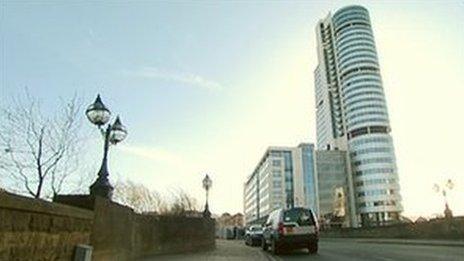Bridgewater Place wind reduction plans go before council
- Published

The 367ft (112m) high Bridgewater Place building was built in 2007
Proposals to protect people from dangerous winds around Yorkshire's tallest building are to go before councillors for the first time.
Strong winds at Bridgewater Place in Leeds blew a lorry over in 2011, killing pedestrian Edward Slaney.
The building's owners CPPI want to put up four baffles across Water Lane to deflect wind, three vertical screens and a glass canopy on the building.
Nick Sinfield, of CPPI, said he believed it was "the right scheme".
Plans to spend £245,000 designing a solution to the wind tunnel effect around the building were first approved by Leeds City Council in February 2013.
Pre-application plans are to be debated by Leeds council's plans panel on 16 January, before any formal application is submitted.
The building's owners said testing on the scheme was still being done.
'Great promises'
Councillor Neil Taggart, who is chairman of the city plans panel, said: "We have a pre-application presentation because we want the applicant to get it absolutely right.
"I'm hoping we then get planning permission as soon as possible, with work starting this year."
The baffles across the road are planned to be about 66ft (20m) long and 13ft (4m) deep.
Large screens are also planned on one of the building's corners and a glass canopy that would cover part of the building.
Ian Pennock, a barrister representing the family of Mr Slaney, said: "The reality is it is seven years since the problem was first known about and we don't even have a planning application, just a pre-application plan.
"To some extent it can be viewed as one of those great promises such as 'the cheque's in the post'."

The scheme is designed to ease the wind speeds and stop the wind tunnel effect
He said the proposed baffles across Water Lane would be "big and ugly" but were a "necessity".
The building owners said the technology had taken "many years to develop".
Mr Sinfield said: "We believe that it is the right scheme to help alleviate the winds surrounding Bridgewater Place.
"The principle of the scheme is based on research that was jointly commissioned by Leeds City Council and the building owner.
"The technology has been developed to meet or exceed the standards set out in that research."
On 10 March 2011, Dr Slaney, a 35-year-old environmental engineer from Sowerby Bridge, West Yorkshire, was walking on a bridge over the River Aire in Neville Street when a lorry toppled over on to him.
The inquest into his death heard the area around the tower had become known for strong winds since it was completed in 2007.
Coroner Melanie Williamson has said the junction should be closed to all users when gusts reached about 45mph.
The authority's current policy is to close the roads to vehicles, including bicycles, when wind speeds reached 65mph.
- Published6 December 2013
- Published5 December 2013
- Published4 December 2013
- Published2 October 2013
- Published29 August 2013
- Published1 March 2013
- Published9 February 2012